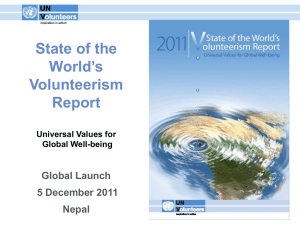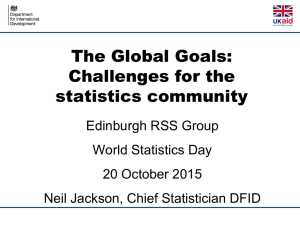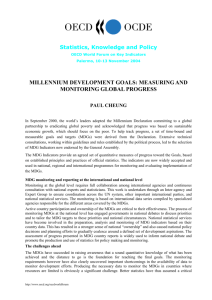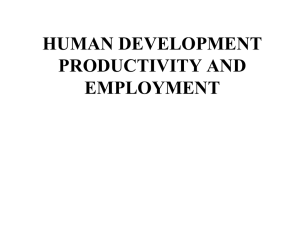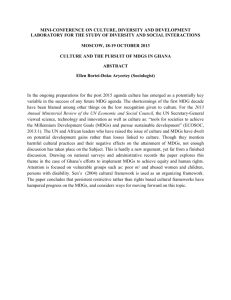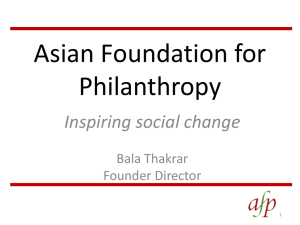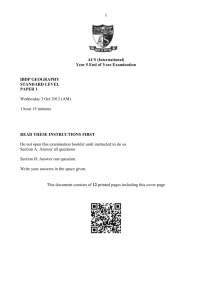Poverty and Inequality Analysis in a Standard CGE Framework
advertisement
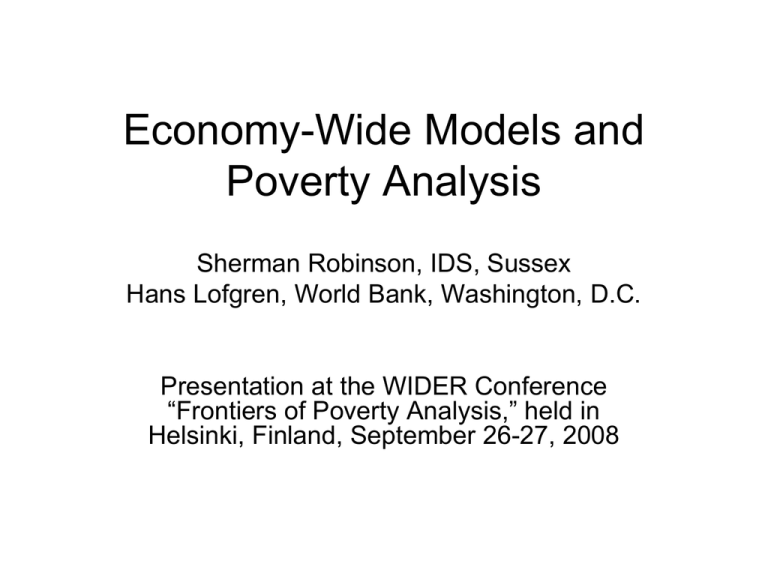
Economy-Wide Models and Poverty Analysis Sherman Robinson, IDS, Sussex Hans Lofgren, World Bank, Washington, D.C. Presentation at the WIDER Conference “Frontiers of Poverty Analysis,” held in Helsinki, Finland, September 26-27, 2008 Introduction • Policy Issues: Poverty and MDGs • Economy-Wide framework – Link development strategy choices with poverty and MDG outcomes – Top-down versus bottom-up approaches • Analytic and empirical models – CGE models with representative households – Households and microsimulation models – MDG links 2 What do we want to capture? Macroeconomic Environment Structural features Binding macro constraints General Equilibrium effects Factor markets Factor market functioning Segmentation Wage determination Households Heterogeneity Human and physical capital Demographic Composition Preferences Access to Markets 3 Typical model structure Costs Returns Factor markets Domestic private savings Taxes Activities Sales Households Intermed. demand Sav. / Invest. Transfers Commodity markets Imports Government Private cons. Exports Invest. demand Gov. cons. Foreign transfers Foreign savings Rest of world Data requirements Household surveys (LSMS) National accounts (RMSM) Trade data (Cust. & Excise) Labor force surveys + B.o.P. (RMSM) Supply/use table = Social Accounting Matrix (SAM) (already available for many countries) 4 A National SAM Expenditures Receipts Activity Activity Commodity Institutions Hshlds World Total sales Commodity Intermediate inputs Factors Value added Institutions Indirect taxes Final demand Indirect taxes and tariffs Hshlds World Totals Factors Consumption Exports Factor income Saving taxes Saving taxes Factor income Payments to hshlds transfers remittances Hshld income Foreign Exchange inflow Inflows Imports Total costs Total supply Factor income Institution income 5 CGE Models • CGE models are widely applied to policy analysis both in developed and in developing countries. – Many applications in trade policy • “Standard” static and dynamic models – Various approaches to incorporating distributional features: poverty and MDGs 6 Modeling Impact of “shocks” on poverty and income distribution • “Shocks” include: – Macro shocks and structural adjustment – Trade reform: country, regional, global – MDG development strategies • Most existing studies of the distributive effects of shocks rely either on: – comparison of distributions before and after the shock, – counterfactuals based on macro models with some disaggregation of the household sector. 7 Counterfactual Analysis • Links between policy changes and impacts – Single policies and strategies (e.g., MDGs) • Decomposing the impact of shocks – Exogenous shocks (e.g., Asian crisis) – Policy responses • Historical analysis: analyzing causes – Turkey 1972-77: Dervis, de Melo, and Robinson – Model as a measurement device 8 Poverty Analysis • Two basic approaches – Representative households in country models • Summary representation of income distribution within household groups – Microsimulation models at household level • Separate, linked, or integrated with economy-wide models 9 Representative Households • Standard approach in early income-distribution focused CGE models. (Adelman-Robinson. Recent: Decaluwe et al.) – First, classify households into “representative” groups. – Second, assume that the relative within-group income distribution for each representative group does not change, given the shocks being analyzed. • CGE model generates changes in group mean incomes. – Distributional statistics generated by aggregating within-group distributions – Generate standard distribution/poverty measures 10 Representative Households • Linking activities, factor incomes, households – Functional distribution – Extended functional distribution – Livelihood strategies by households • Household disaggregation – Within-group distributions not affected, so model cannot explain or affect much poverty/inequality – Representative to full household surveys 11 Microsimulation “... instead of aggregating observations within a household survey into a few household groups in conformity with the requirements of CGE-type models, our aim should be to work directly with all the individual observations of the survey. By doing so, we hope to achieve full consistency between macroeconomic reasoning and standard poverty evaluation.” Bourguignon, 1999. 12 Microsimulation • Integrated CGE - microsimulation model • Top-down approach • sequential approach with CGE model feeding microsimulation with price and income data • No feedback from micro to macro levels • Different degrees of complexity at the microsimulation level – Models of household behavior 13 Simple Top-Down Approach • Link model results to a household survey. – Survey households are classified the same as representative households in CGE model. – CGE model generates incomes and prices – Individual survey observations scaled using simulated changes in representative household income and prices. – Distributional measures computed from adjusted survey. 14 Microsimulation • The essence of microsimulation is to model the behavior of individual agents (households or firms) that are included in a micro database. • In order to extend the analysis from partialequilibrium issues, microsimulation models can be linked to CGE models. – Potential to link economy wide shocks to household outcomes 15 The Sequential Framework Macro-level module (Extended CGE-type model) - Occupational structure: L - Price variables: p - Wage and earnings: w - All other variables in macro module: Y Link variables: L, w Micro-simulation module (Household survey) - Socio demographic characteristics: Si - Occupational/labor-supply choice: - Income: li = O(Si,) yi = E(Si,).li Consistency with macro. Find changes in parameters and such that: li = L and Mean E(Si,) = w Outcome = change in distribution of income conditionally on characteristics S. 16 UNDP Latin America Studies • UNDP Projects on Latin America: – Trade: 16 country studies • Top-down CGE - microsimulation – CGE models with focus on international trade • Various degrees of household disaggregation – Income, employment, and prices sent down – Limited behavior at household level • Latin American school of microsimulation 18 UNDP Latin America Studies • UN Projects on Latin America: – Trade – with IFPRI, 16 country studies – MDG Strategies – with World Bank; 18 country studies • Top-down CGE - microsimulation – CGE models with focus on international trade • Various degrees of household disaggregation – Income, employment, and prices sent down – Limited behavior at household level • Latin American school of microsimulation 19 The Integrated Framework Macro-level module (Extended CGE-type model) - Occupational structure: L - Price variables: p - Wage and earnings: w - All other variables in macro module: Y Micro-simulation module (Household survey) - Socio demographic characteristics: Si - Occupational/labor-supply choice: - Income: li = O(Si,E) yi = E(Si,w).li E = earning rate of individual/household i in various occupations. These “personal” rates are a function of a set of standard market rates, w. Outcome = change in distribution of income conditionally on characteristics S. Aggregating: li = L 20 Microsimulation vs RH models • Comparing RH models and microsimulation – When does disaggregation matter? • Household impact and behavior – If “shocks” affects variables such as prices or average wages, RH models do fine – If “shocks” affect employment or discontinuous household behavior, microsimulation matters • Labor participation • Distinction is not sharp: continuum of models 22 MAMS – Maquette for MDG Simulations • Dynamic-recursive CGE Model for MDG analysis; developed at World Bank – – – • • • Initial motivation: need to address country-level MDG strategies: How can government policies, with foreign aid providing part of the financing, be designed for achievement of the MDGs? Evolved into general framework for country-level, medium-to-longrun development policy analysis, with emphasis on fiscal issues and MDGs. Different versions (differing in data needs and issues they can address) ranging from aggregated macro to disaggregated MDG. Starting point: standard dynamic-recursive CGE model Main innovation: covers the generation of MDG and education outcomes. MAMS has been used with the standard approaches to poverty and inequality analysis. 23 MAMS • Applications in many countries: – – – • 18 in Latin America and the Caribbean 9 in Sub-Saharan Africa 5 in MENA region Used in the context World Bank country analysis (including Country Economic Memoranda, Public Expenditure Reviews, Poverty Assessments) as well as in joint work with the UN (UN-DESA and UNDP) on Latin America and the MENA region. 24 Issues in MDG strategy analysis • A framework for analysis of MDG strategies should consider the following factors: 1. Synergies between different MDGs 2. Role of non-government service providers 3. Demand-side conditions (incentives, infrastructure, incomes) 4. Role of economic growth 5. Macro consequences of increased government spending under different financing scenarios 6. Diminishing marginal returns (in terms of MDG indicators) to services and other determinants 7. Role of efficiency and input prices (e.g. wages) in determining unit service costs 25 MAMS: Model Structure • An extended, dynamic-recursive computable general equilibrium (CGE) model designed for MDG analysis. • Complementary to and draws extensively on sector and econometric research on MDGs. • Motivation behind the design of MAMS: – An economywide, flexible-price model is required for development strategy analysis. – Standard CGE models provide a good starting point. – But standard CGE approach must be complemented by a satisfactory representation of “social” sectors. 26 2. Model Structure MAMS: Model Structure • • Extended to capture the generation of MDG outcomes. MAMS covers MDGs 1 (poverty), 2 (primary school completion), 4 (under-five mortality rate), 5 (maternal mortality rate), 7a (water access), and 7b (sanitation access). • The main originality of MAMS compared to standard CGE models is the inclusion of (MDG-related) social services and their impact on the rest of the economy. • Social services may be produced by the government and the private sector. 28 2. Model Structure MAMS: Role of Government • Government services are produced using labor, capital, and intermediates (fixed coefficients for capital, intermediate inputs, and aggregate labor; flexible coefficients for disaggregated labor). • Government spending is split into – Recurrent: consumption, transfers, interest – Capital (investment) • Government demand (consumption and investment) is classified by function: social services (education, health, water-sanitation), infrastructure and “other government”. • Government spending is financed by taxes, domestic borrowing, foreign borrowing, and foreign grants. • Model tracks government domestic and foreign debt stocks (including foreign debt relief) and related interest payments. • Simplified versions of equations for government recurrent receipts, recurrent expenditure, savings, and investment expenditure….. 29 2. Model Structure MAMS: MDG “production” • • Together with other determinants, government social services determine the "production" of MDGs. MDGs are modeled as being “produced” by a combination of factors or determinants (table following) using a (reduced) functional form that permits: – Imposition of limits (maximum or minimum) given by logic or country experiences – Replication of base-year values and elasticities – Calibration of a reference time path for achieving MDGs – Diminishing marginal returns to the inputs • Two-level function: 1. Constant-elasticity function at the bottom: Z = f(X) 2. Logistic function at the top: MDG = g(Z) 30 MAMS: Data Requirements • Core needs are similar to other CGE models: – Social Accounting Matrix (SAM); stocks of factors, population, and debts (foreign and domestic); elasticities in trade, production, and consumption; • They depend on the (flexible) disaggregation of the model. • The SAM is used to define most of these parameters. • Requirements specific to MDG version: – In SAM: government consumption and investment disaggregated by MDG-related functions; labor disaggregated by educational achievement; – Education parameters: stocks of students by educational cycle; student behavioral patterns (ex: rates of passing, repetition, dropout); population data with some disaggregation by age; – MDG data: indicators for base-year and 1990; elasticities; calibration scenario for achieving each MDG. MAMS: MDG Scenarios • The BASE scenario is a “business-as-usual” continues that may have the following characteristics: – Growth in GDP reflects trend of last 5-15 years. – Unchanged GDP shares for government demand, foreign aid, and debt stocks. – Other policies are unchanged or adjusted according to trends. – Other exogenous items grow at the same rate as GDP. • The BASE scenario serves as a benchmark for comparisons. Examples of MDG Scenarios • Questions commonly addressed by non-BASE scenarios: What happens if the government … 1. expands services sufficiently to reach the MDGs with additional financing provided by (a) foreign grants; (b) domestic taxes; (c) domestic borrowing? 2. contracts in one area (e.g. human development or other government) and expands in another (e.g. infrastructure) with unchanged aid and domestic policies? 3. expands in one area with additional financing from a, b, or c (as defined under 1)? 4. becomes more/less productive, adjusting one or more types of spending or financing in response? MAMS: Ethiopia Study • BASE (as described above) • MDG-BASE (core MDG scenario): – Government service growth is sufficient to achieve all HD MDGs (2, 4, 5, 7a, 7b) by 2015 – Foreign grants are unconstrained; adjust to meet the government financing gap • Various simulations exploring tradeoffs among MDGs and issues of timing and costs. Ethiopia: MDG Values 1990 2002 goal: 2015 38.4 36.2 19.2 MDG 1 headcount poverty rate (%) MDG 2 primary (1st cycle) net completion rate (%) 24 36 100 MDG 4 under-five mortality rate (per 1,000 live births) 204 163 68 MDG 5 maternal mortality rate (per 100,000 live births) 870 609 218 MDG 7a access to safe drinking water (%) 25 24.4 62.5 MDG 7b access to safe sanitation (%) 8 12 54 Key Ethiopia findings • Foreign aid per capita increases five-fold to US$79 in 2015 as compared to 2005. • Heavy reliance on foreign aid appreciates the real exchange rate appreciation and skews production toward non-tradables. • In the educated part of the labor market, wage increases are initially rapid but will later slow down when labor supplies increase and the scaling-up period is concluded. • Relative to an emphasis on infrastructure, a human development focus puts the economy on a slower growth track. Poverty Analysis: The Road Ahead • Improving microeconomic specifications – Intertemporal household behavior • savings and investment: physical and human capital • demographic changes and migration – Intra-household allocation of resources • Improving market specification in rural sector – segmentation and market failures in factor markets (land, labor, credit), – spatial and regional dimensions in markets for goods (access to markets, transaction costs) 38 Poverty Analysis: The Road Ahead • Microsimulation model of producers (farms, firms) as well as households. • Issue: use more representative actors without moving to specification of all observations in survey samples. – Techniques of “data reduction” without loss of important information. • In MDG/MAMS: better models of links between govt policy and MDG outcomes 39 Poverty Analysis: The Road Ahead • No single approach is likely to dominate – Informational demands and operational constraints vary across applications • Data: reconciling household/firm data with national accounts and SAM data – Important for any poverty analysis. – Separation of economywide and household analysis represents a methodological failure • Need for reconciliation and integration 40
